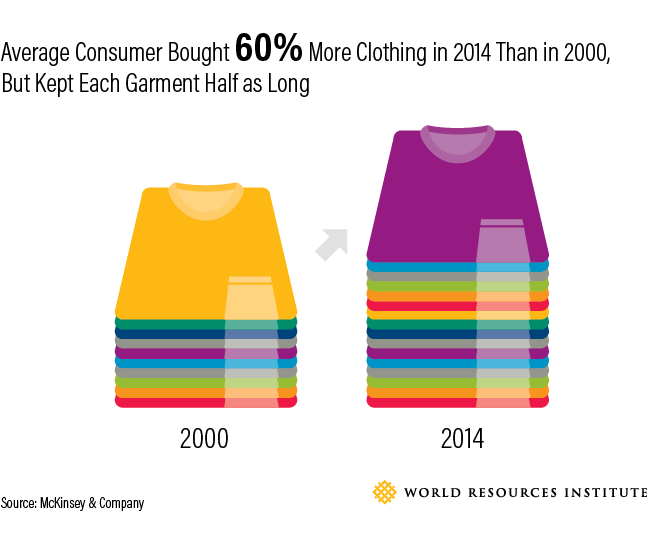
Circular Fashion: Rethinking the way forward for India’s fashion industry
This blog series is part of an ongoing project by WRI and its partners to encourage apparel companies to break away from traditional business models and invest in clothing reuse - resale, rental, and repair models.
Until a few years ago, Indian households followed a typical pattern of using clothes. A new shirt was first worn by the eldest child, followed by younger siblings and cousins. If it was still in a somewhat wearable condition, it was given to the house help and if not, it ended up as a cleaning cloth. Recently, however, Indians increased their spending on clothes by 181% in just 8 years - from ₹1,924 billion in 2010 to ₹5,408 billion in 2018. This is expected to rise further due to economic growth, population rise, and the expansion of the middle class. With growing purchasing power, consumers are expected to shift from need-based purchasing to aspiration-based purchasing.
 The average consumer bought 60% more clothing in 2014 than in 2000, but kept each garment half as long. (Source: McKinsey & Company)
The average consumer bought 60% more clothing in 2014 than in 2000, but kept each garment half as long. (Source: McKinsey & Company)
India is poised to become the world’s sixth largest apparel market in 2022, moving the country from being a manufacturing hub to also becoming a major consumption market. As a result, India’s fashion industry is expected to play a crucial role in fulfilling domestic and global demand, as well as generating income and employment. Despite its economic significance, the fashion industry has come under increased scrutiny for its enormous social and environmental impacts. Today’s fashion industry follows the linear production model and is built on the premise of ‘fast fashion’. The linear fashion model refers to an economic model that relies on increasingly extracting natural resources, making clothes at lower costs, and disposing them after a few uses. The idea of fast fashion is to provide consumers with a ready flow of cheap clothing, often of low quality. Fast fashion has increased the number of fashion seasons from two a year (summer and winter) to up to 50-100 micro-seasons. Consumers in 2014 purchased 60% more clothing, but each garment was kept for half as long compared to 2000. This has created a two-fold problem of overconsumption of resources and waste generation.
The problem lies in the manner in which fashion companies measure success. It is based on the number of clothes sold annually and year on year growth of sales. This approach, however, does not take into account the planetary boundaries and the finite nature of natural resources. The linear production model has been successful in driving profits for the fashion industry so far. But the high hidden costs make it untenable to continue on the current trajectory. To put things in perspective, business-as-usual would mean that by 2050, the fashion industry could use more than 26% of the global carbon budget associated with a 2°C pathway.
If we are to meet future demand within the planetary limits, we need to radically rethink the way we do business. Boosting resource efficiency or enforcing end-of-pipe solutions such as waste management can only address the symptoms but not the deeper problem of how we are producing and why we are consuming so much. We need to reduce our dependence on virgin materials and transform the way we produce, use and dispose our clothes.
This requires us to move from a linear to a more circular fashion system in which clothes are made from safe and renewable materials. Designed for longevity, these garments are reused, repaired, refurbished, and once they reach their end of life, they are recycled into new clothes. The idea is to optimize the stock of apparel by maximizing the utilisation of the clothes that are already produced and keeping them flowing in the economic system at their highest material value, for as long as possible.
India is at a crossroads: Can we go back to our old ways of living? Or leave it to individuals to adopt more sustainable lifestyles? The circular economy approach offers us the opportunity to leapfrog to a more sustainable model that is designed to maximize material productivity, minimize waste, and decouple growth from resource use. Subsequent blogs in this series will introduce new business models for apparel companies and the enabling conditions required for this transition.